BOLIVIA
History

History

History
Pre-Columbian Period
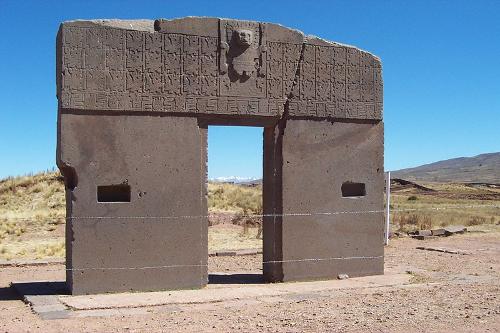 The Gateway of the Sun from the Tiwanaku civilization in BoliviaPhoto: Public domain
The Gateway of the Sun from the Tiwanaku civilization in BoliviaPhoto: Public domain
It is believed that the indigenous people of the Americas, the Indians, crossed over from Asia to America tens of thousands of years ago. Thousands of years later, the entire American continent was inhabited. It is also believed that other nations also came to America. Striking in this respect are the similarities between the Andean languages Aymará and Quechua and the Polynesian. There are also clear similarities in appearance. Human habitation in the Andes dates back to at least 13,000 BC, including the Vizcachani culture. These nomadic tribes switched to agriculture and animal husbandry from 6000 BC. Little is known about the way of life of these ancient cultures. This entire period until about 3000 BC. is also called the pre-ceramic period.
The ceramic period lasted from 3000 BC. until about 1500 AD. Much more has become known of this period for pots and vases painted with symbols and decorations, but also beautiful weaving art tells a lot about the history of the different cultures. The most important culture in Bolivia from that time has been the Tiwanaku culture. This culture was characterized by highly specialized agricultural methods that produced abundant food for that time. This is probably also one of the reasons that this powerful culture has remained at the forefront of this region for so long. The sudden disappearance of this culture in the early 12th century is a mystery to this day, but it was probably related to climatic conditions. There were some other, smaller cultures in what was then Bolivia, including the Beni in the tropical lowlands, the Kolla culture around Lake Titicaca, the Wankarani and Chiripa. The Wankarani have left square towers and the Kolla gigantic round towers.
The Inca Empire
From the capital Cusco in Peru, Bolivia came under the rule of the Incas (1200-1500 AD). The language of the Incas, Quechua, had to be spoken by every subject and is still one of the official languages of Bolivia today. The Inca Empire was divided into four areas of which Collasuyo included a large part of Peru, all of Chile, some northern Argentina and present-day Bolivia. The Incas built roads and aqueducts, terraces, fortresses and temples. Large cities also sprang up in the plains. Ultimately, 43 different nations had become Inca subjects. The Inca occupation of Bolivia would eventually only last 70 to 80 years. Around 1520, the Inca Empire slowly crumbled due to internal conflicts, among other things.
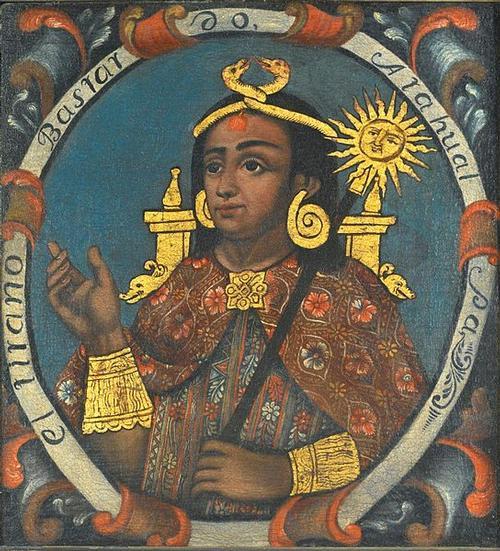
Spanish conquerors (conquistadors)
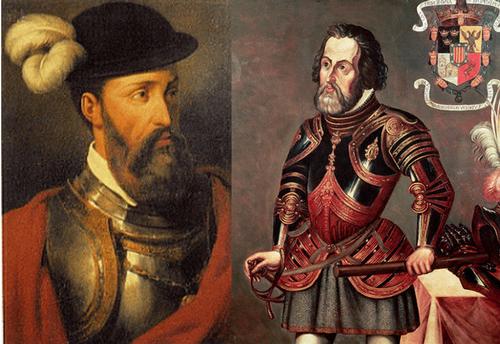 Pizarro BoliviaPhoto: Urituguasi CC 3.0 Unported no changes made
Pizarro BoliviaPhoto: Urituguasi CC 3.0 Unported no changes made
In 1532 an expedition led by the Spaniard Francisco Pizarro (murdered in 1538) came ashore on the north coast of Peru. The last Inca prince Atahualpa was killed and relatively quickly large parts of the South American continent were conquered. Bolivia was then still called Alto-Perú (Upper Peru) and was added to the viceroyalty of Peru. Cities were founded on and around the plateau and later the tropical lowlands were also colonized. After the discovery of silver deposits, the city of Potosí was founded in 1545, which quickly grew into the largest and richest city in the New World (North and South America) with 200,000 inhabitants. It was called by the Spaniards “La ville imperia”, the imperial city.
The encomienda system was used by the Spaniards. This meant that the conquistadors were allowed to exploit as much of the land that was conquered as they could. Proceeds were shared between the conquistadors and the Spanish Crown. Another condition was that the Native American population had to be converted to Christianity. The Indians were, among other things, employed in the mines and had to do their work under terrible conditions. By the end of the sixteenth century, the Native American population was already in a dramatic decline; millions of Indians were killed by forced labor. Due to the working conditions in the mines, but also due to the outbreak of contagious diseases brought by the Europeans, the Indian population had almost halved to half a million people by 1650.
Due to the shortage of labor, slaves were quickly imported from Africa on a large scale. Monks of the Jesuit Order, and later the Franciscans, spent the first 200 years converting the Native Americans to Christianity. Over the centuries, the Roman Catholic faith mixed with the traditional rituals and customs. La Paz was founded in 1548 and some later cities such as Cochabamba and Oruro. After hostile actions by Indians in the East and Northeast, some form of self-government was first allowed by the Spaniards around 1560.
The 18th century was marked by growing resistance from the Native Americans to Spanish rule. In 1780, for example, Tupac Amaru led a revolt of the Quechua and Amayá against the colonial government. However, they were defeated and their leaders murdered. Tupac Katani even later besieged La Paz twice, but he was eventually killed too. Yet it would not be long before Bolivia became independent.
Bolivia independent
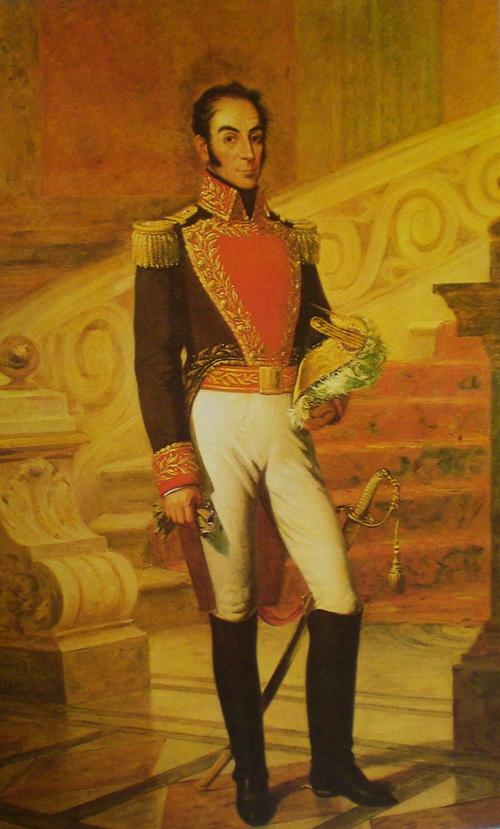 Simon Bolivar BoliviaPhoto: Public domain
Simon Bolivar BoliviaPhoto: Public domain
The power of the Spaniards in Europe and therefore also in South America crumbled because Napoleon invaded Spain. Under the criollo's, the white South Americans, various groups of people quickly emerged who spoke out for independence, among other things because the Spaniards always put the interests of the motherland first. The most important was Símon Bolívar (1783-1830) who, together with his marshals José de Sucre and José San Martín, liberated almost all Spanish colonies from 1810 with his military army. In April 1825 Sucre defeated the Spaniards in Upper Peru at the Battle of Tumusla and on August 6, 1825 the independence of the “República de Bolívar” was proclaimed, the name of course in tribute to the freedom fighter Bolívar. Later the name Bolívar would change to Bolivia.
Bolívar and Sucre were Bolivia's first two presidents. Many presidents and governments would succeed them in this politically troubled country. Between 1825 and 1994 there were 194 changes of government; more than half of them were military governments (dictatorships), while the Roman Catholic Church also played a major role in domestic political affairs. Bolivia has also had 16 different constitutions since 1825. The mines and communal farms came into the hands of the whites, so that the Indian farmers and miners were treated like slaves.
Bolivia is losing a lot of territory to neighboring countries
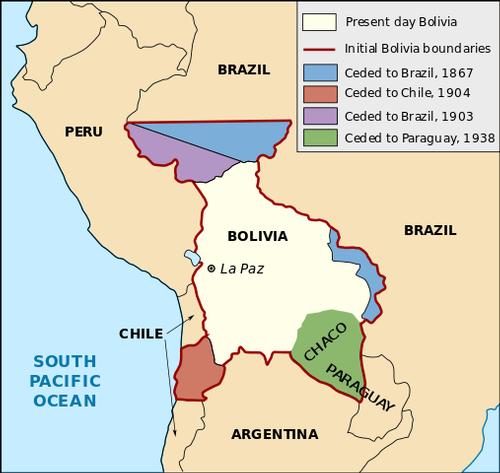 Bolivia Map with area distance to neighboring countriesPhoto: Public domain
Bolivia Map with area distance to neighboring countriesPhoto: Public domain
Remarkable in Bolivia's history is the loss of much territory to neighboring countries. Since its independence in 1825, Bolivia's surface has been roughly halved. For example, Bolivia, together with Peru, had a large piece of territory in the north of today's Chile until 1884. Important for Bolivia that the piece of land bordered on the Pacific Ocean. Both countries went to war with Chile from 1879 to 1884 and eventually lost the area to the Chileans. This war is called the “Nitric War” because it also fought for the rights to extract salt and copper in the coastal area. From that time on, Bolivia no longer has an open connection with the ocean. Bolivia was still allowed to build a railway that ran from La Paz to the port of Arica, which Bolivia could use for a fee.
Brazil annexed the rubber regions of Acre in northern Bolivia at the turn of the century. Here, too, Bolivia was given the right to build a railway from Riberalta in Bolivia to Rio Madeira as a satisfaction. Under the rule of the Presidents Pando (1899-1904), Montes (1904-1909 and 1913-1917) and Villazon (1909-1913), the country experienced an economic boom, as the raw materials rubber and tin entered the world markets during the First World War. high prices. In 1917 Bolivia severed relations with Germany, but it did not take an active part in the war.
Between 1928 and 1935, the Chaco Wars raged between Bolivia and Paraguay. Oil was suspected in northern Paraguay (Gran Chaco). The oil companies Standard Oil Company (Bolivia) and Shell (Paraguay) played a major role in this war for concessions. Tens of thousands of Bolivians were killed, and the distressing thing was that no petroleum was ever found in the Gran Chaco. Poverty among the population increased after this failure and new political parties and trade unions were formed. The petroleum industry at that time was almost entirely in the hands of the Standard Oil Company and the tin mines in the hands of three families (Hochschild, Patiño and Aramays). However, this did not lead to major economic development or social progress. In the late 1920s, more than half of the national income had to be spent annually on repaying debts. This led to a revolution in 1936.
Civil wars, conflicts, strikes, uprisings
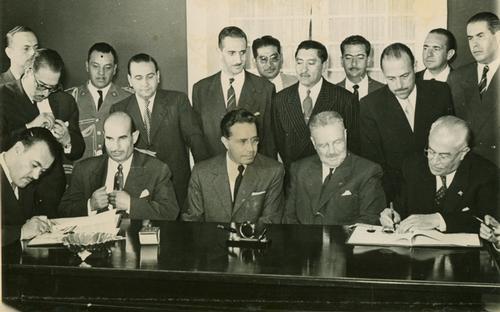
President Toro tried to introduce state socialism, but he met resistance from the foreign companies present in Bolivia. One of his successors, General Peñaranda, was overthrown by nationalist groups in 1943. During an uprising in July 1946, Peñaranda's successor, Villaroel, was murdered by an angry mob. In January 1947, the right-wing socialist Hertzog was elected president. His party did not have a majority in parliament and the Nationalist Revolutionary Movement was constantly trying to take power. These disputes degenerated into civil war in 1949, but thanks to the support of the army, Hertzog managed to survive. The revolt was suppressed, but the fierce criticism of his policies forced Hertzog to resign.
During the 1952 Revolution, the National Guard, along with the miners, defeated the army. Power fell into the hands of Victor Paz Estenssoro. However, the army took power before he could take up his position. In April 1952, after a popular uprising lasting several days, the popular militias led by Hernán Siles Zuazo defeated the army. Estenssoro was installed as president and carried out major socio-political reforms and ended the power of some powerful families by nationalizing large tin mines. In 1952 universal suffrage was also introduced and the feudal system of large land tenure was abolished. All farmers were given some land, but this fragmentation led to even greater poverty among farmers and greater migration to the cities.
In the 1956 elections, the MNR won an overwhelming majority of votes; Siles Suazo became president. Uprisings and strikes were the order of the day during his reign and the country was almost constantly in a state of emergency. The 1960 elections brought Paz Estenssoro back to power. In 1963, President Estenssoro came into conflict with the vice president, Lechín, who was also the leader of the miners' union. This brought on the displeasure of the miners. Despite much criticism of his policies, Paz Estenssoro was re-elected president in May 1964, but after an army uprising, power was taken over by Vice President, General R. Barrientos Ortuño. During his reign, noted freedom fighter Ernesto Che Guevarra was captured and murdered because he was believed to be planning a peasant uprising. Barrientos died in 1969 and was succeeded by the commander in chief of the armed forces, Ovando.
Bolivia under the yoke of dictators
In 1971 another coup followed, after which General Hugo Banzer remained in power until 1978. During his regime, universities were closed, trade unions and political parties were banned and tens of thousands of people were arrested without trial. The clergy protested against the frequent violations of human rights in Bolivia. Political opposition to Banzer came from both the left and the right.
In June 1974 left-wing officers revolted, after which Banzer, among other things, promised parliamentary elections, which he even had laid down by law. In the meantime it had become clear that Banzer had become completely dependent on the right-wing officers: under their pressure, he also postponed plans for elections for five years. Banzer was followed by a whole series of dictators (caudillos), the low point of which was General García Meza, whose reign was marked by torture, murders, connections with the drug trade and ultimately a practically bankruptcy in Bolivia.
Democracy returns
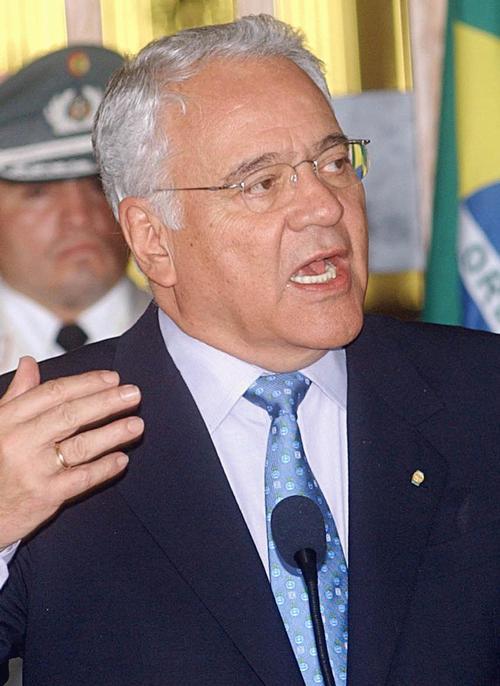
In 1982, power was turned over by the military to a civilian government led by Hernán Siles Zuazo. Bolivia was completely bankrupt at that time and the Zuazo period was therefore characterized by enormous monetary devaluation, much social unrest, strikes, high unemployment and an ever-increasing foreign debt. In 1984 inflation averaged 3% per hour !! Bolivia was already a major cocaine producer at the time, but in these difficult times the lucrative trade (in hard dollars) became increasingly important to the country's economy. From 1982 the Americans tried to control the cocaine trade in Bolivia in exchange for economic aid. Estenssoro won the election again in 1985 and took a number of rigorous measures to rebuild the economy. For example, government spending was decentralized and heavily loss-making state-owned enterprises were closed or privatized. The result was that many mines were closed and tens of thousands of miners were left without work. The unexpected collapse of the world tin market in 1985 also cost many employees their jobs. At that time 90% of the population was living below the poverty line.
In 1989 Vice President Jaime Paz Zamora was elected president. He co-ruled in a coalition with ex-dictator Hugo Banzer, who was strangely responsible for an attack on left-wing politicians during his previous rule, in which Zamora narrowly escaped death. In July 1993 Bolivia was granted narrow access to the Pacific Ocean from Peru until 2091 by way of a concession. In 1993, the popular Gonzalo Sánchez de Lozado came to power and formed a coalition with Hugo Cardenas, an Aymará Indian from the Indian party MRTKL, through which part of the Indian population was directly represented in parliament. They carried out an economic reform program, including a very ambitious privatization program, with associated many social measures (Plan de Todos), decentralization, educational reforms and constitutional changes. A program was also set up to improve the position of the Indian population, for example by allowing bilingual education. However, he was unable to get a second term to the government.
On August 6, 1997, ex-dictator Hugo Banzer was sworn in as president. He especially attracted many voters who hoped that the economic growth of the 1970s would return with him. Opponents of Banzer were human rights activists who felt he should pay for his past. They also feared that militarism would return. One of his first acts seemed to confirm this: the destruction of coca fields with the help of the military. One of his promises in the election campaign was that all illegal coca fields would be destroyed in five years. In 1998 more than 11,000 ha was destroyed. Furthermore, he mainly benefited from the reform program of his predecessor Sánchez de Lozado.
In April 2000, there were violent protests against the proposed privatization of the drinking water supply, which increased the price of water by 35%. The situation got so out of hand that the government declared a state of emergency. On July 27, 2001, President Banzer resigned due to health problems. He was succeeded by Vice President Quiroga. After weeks of social unrest that would have claimed the lives of 60-80 people, President Sánchez de Lozada resigned in October 2003. Vice President Carlos Mesa was appointed as the new president. Sánchez de Lozada fled to the United States, which had always strongly supported him.
In early June 2005, President Mesa announced elections to a constitutional council to revise the constitution. There would also be a referendum on more autonomy for the oil-rich provinces in the east and south of the country.
Mesa hoped to end the violent protests, roadblocks and a 48-hour strike that paralyzed transport across the country. The protesters demanded nationalization of oil and gas extraction. Especially the poor western provinces, where many poor Indians live, wanted a larger share of the proceeds.
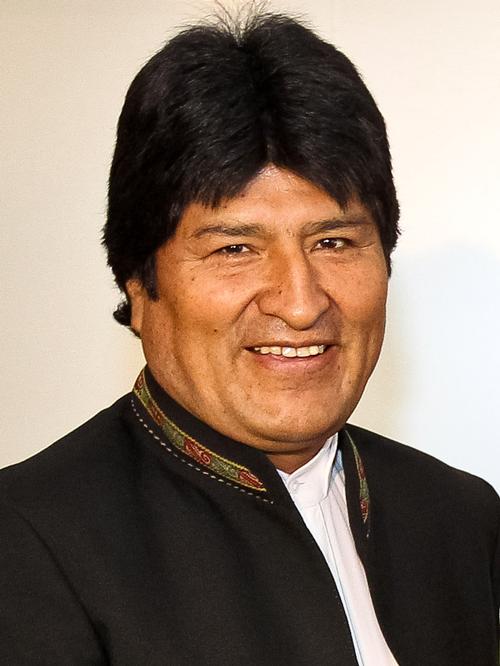 Eva Morales BoliviaPhoto: Roberto Stuckert Filho/PR CC 2.0 Genérica no changes made
Eva Morales BoliviaPhoto: Roberto Stuckert Filho/PR CC 2.0 Genérica no changes made
The December 2005 presidential election was won by left-wing indígena (native Indian) Evo Morales Ayma. He won with more than 51% of the vote and became Bolivia's first Indian president. The old political order was wiped out by the voters in these elections. A period of nationalization of, among others, the gas industry follows. In May 2008, Morales agreed to a referendum on his leadership in August, if he loses the referendum, new elections will follow. In August 2008, Morales won the referendum with 67% of the vote. In January 2009, a new constitution gives more rights to the indigenous peoples. President Morales wins the election in December 2009 with more than 60% of the vote. In May 2010, he met with the Pope and nationalized four electricity companies. In May 2013, a law is passed allowing Eva Morales to serve a third term as president. He will indeed be re-elected in October 2014. In February 2016, the population will vote in a referendum against the possibility of a fourth term. In March 2017, Morales signed a controversial law that doubles the area of legal Coca cultivation. In November 2019, Morales will retire due to a constitutional crisis following controversial elections. Since then, Senator Jeanine Áñez of the opposition has been interim president until new elections are held. The elections were originally scheduled for May 2000, but due to the COVID crisis they have been moved to November 2020. Luis Acre won the October 2020 presidential election, returning the Mas socialist party to power after a 12-month interregnum.
Sources
Bijl, Y. van der / Reishandboek Bolivia
Elmar
Lindert, P. van / Bolivia : mensen, politiek, economie, cultuur
Novib
Schimmel, K. / Bolivia
Chelsea House Publishers
Sprey, J. / Bolivia
Gottmer
Te gast in Bolivia
Informatie Verre Reizen
CIA - World Factbook
BBC - Country Profiles
Copyright: Team The World of Info